Edible Weeds Provide a Free Garden Bonus
Edible weeds in your garden make easy pickings!
We work hard to produce crops from our gardens and allotments. Wouldn't it be good if we could just pick the food we needed with little or no effort?
Well, to some extent, we can do just that. there are quite a few edible weeds in the average garden and there are a few other wild foods which can be encouraged to grow in the garden and will provide easy cropping for salads and other dishes.
Here are just a few ideas, spread over two pages.
Caution!
Please always exercise due caution with plants that you do not know! Poisonous plants can grow in the most civilised places! If you are not sure what it is do not eat it!
Advertisements
Are edible weeds already in your garden?
Most gardens or back yards which have a reasonable level of fertility will produce weeds, especially in the springtime. What grows easily in your soil will depend upon where you are in the world, your climate and your soil. Here I will mainly look at edible plants which are found in temperate regions.
Am I going to wax on about the benefits of nettles? Not really. Many people extol their virtues and certainly they can be prolific in neglected corners of the garden. They do make a reasonably good soup, which has tonic properties for the blood. But, I find them a bit non user-friendly for the most obvious reason! I'm hoping to show you one or two edible weeds that are a little more accessible and more delicious, too.
The first garden edible weed that I'm going to look at is fat hen.
Fat hen
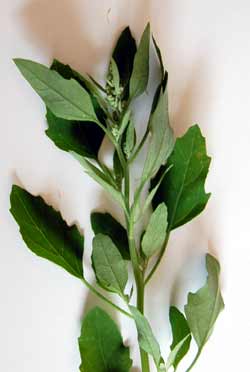
Fat hen stalk and leaves
Fat hen (Chenopodium album) got its name because it does make a good food for hens and other farm animals and the swollen seed head is indeed quite rich in nutrients.
Don't let that put you off exploring its benefits as a vegetable crop for the table! In some parts of the world it is used for human food. In northern India it is sown as a food crop and Bangladeshi people use it in their cuisine.
Seedling crops can be a great addition to stir-fries or soup from around May onwards (northern hemisphere). Just pick clean young top leaves and shoots and use them much as you would use spinach or leaf beet.
I've not used them raw; there is some data to suggest that they are mildly toxic in large quantities owing to the presence of saponins and oxalic acid, causing digestive disturbances. Oxalic acid can cause kidney problems - but many common vegetables contain some oxalic acid; a healthy digestion will cope with small amounts up to around 50 mg per day. Blanching your cooked vegetables helps remove some of it.
I've never noticed any problem with them as a cooked food - in fact they are delicious!
If you are concerned about oxalic acid in your vegetables - and a lot of wild foods do contain some - check out this site for lots of valuable information: www.eatthatweed.com/oxalic-acid/
Later in the summer the plants become tall and stringy. You can still use well selected leaves and even the seed heads when they are first developing. You can also pinch the plants out as they grow to produce more young shoots.
I'm a big fan if Fat hen. It's easily as good as leaf beet, if not better.
Even better than this is its close relative Good King Henry (Chenopodium bonus-henricus). Unfortunately, it is nothing like as common in the UK. Maybe there are places where it is a common weed.
A fairly common close relative of Fat Hen which I find the best of all (so far) is Hastate Orach (Atriplex hastata). It tends to grow near the seaside and its flavour is sublime when fried in a little butter. It has pretty pointy leaves but looks otherwise similar to fat hen. (The word "hastate" means spear-shaped.)
If you live near the seaside it might be worth checking if its growing in your garden.
Spring beauty
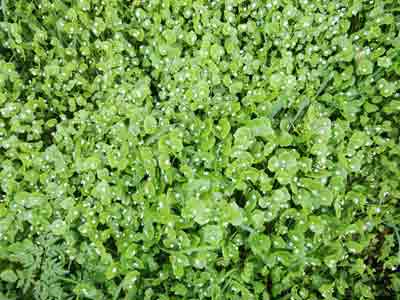
This succulent green plant is well named. It makes a beautiful fresh mat of light green and is usually found under shrubs or hedgerow trees and on shady banks. It is also called Miner's lettuce or Claytonia (Claytonia perfoliata).
It has characteristic round leaves with the stem running through the middle. The young leaves are more pointy shaped. The flowers are small and white or pale pink. It is found in both Europe and north America.
Spring Beauty - a great addition to salads. Note the shallow roots and the pointy young leaves.
You can add it to salads and the taste is fresh and quite appealing. I've been adding it to spring salads for a few years now - and nobody has complained! For me it is far better than chickweed, for example. You can also use it like spinach in stir fries or soups and stews.
You can also buy Claytonia seeds now in the UK. If you establish it in the right conditions it will flourish without much difficulty or attention for years. Growing wild plants for food can sometimes be a viable option. A weed is, after all, only a plant growing where we do not want it. Edible weeds can become proper members of your garden community of plants!
My neighbour tells me her garden was infested with Spring Beauty when she first took it over and she spent years eradicating it. In fact it is very easy to uproot as the roots are quite shallow. I now have a small colony growing in a tub in a half-shady corner of the patio. It enjoys damp, shady conditions but does not mind a bit of sun. The tallest plants tend to grow in the shadiest spots.
Spring Beauty is available from around March to May. Try looking for it on the banks of bridleways and deep country lanes. It is one of the best edible plants that can be induced to grow in the garden.
I now grow it in the greenhouse in the early months of the year as an early salad crop.
Picture below: Spring beauty ready to eat
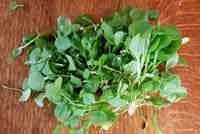
Marsh mallow
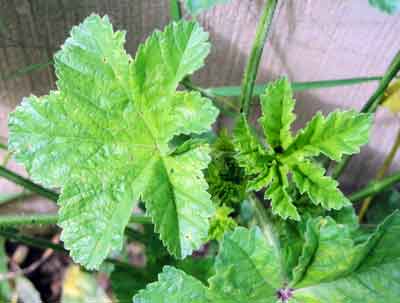
Marsh mallow leaves
The leaves of this big, beautiful weed (Althaea officinalis) are a valuable addition to soups and stews. They are fairly glutinous so they act like a natural bulking agent or thickener. They are highly regarded by people of Turkish origin.
I've used the young leaves quite a bit in springtime and found them to be useful, if a little bland. The seeds are also edible.
Wild hops
I imported a small scion of wild hop into my garden about ten or more years ago. Now it romps freely around the hedge at the bottom of the garden, producing hundreds of slim lithe shoots. If you trim these shoots and throw them into a stir fry they make a tender if slightly bland addition. Some people have compared them to asparagus shoots. I would not go that far - but they are a lot less work.
Wild hops can also be used for brewing beer. I haven't tried this yet.
Dandelion
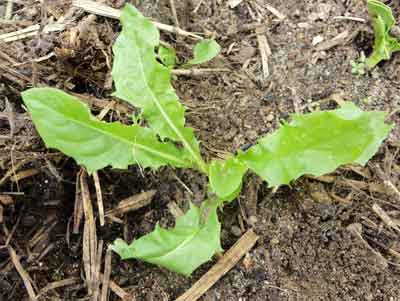
Young dandelion plant seen from above
These beautiful plants (Taraxacum officinale) are little nutritional goldmines! The leaves are very rich in potassium and iron and the flowers are really quite lovely too and can also be eaten. It is a useful herbal remedy with diuretic and tonic properties among others.
Use only the tenderest pale green leaves as they can become quite bitter with age. You can put the plant under a pot for a week or two so that the leaves become blanched. I would suspect that a lot of the nutritional benefit is lost if you blanch them too much.
Dandelion roots can be used to make a tasty substitute for coffee or for inclusion in the traditional drink dandelion and burdock.
You can also make dandelion wine. I have done this but it is a bit too labour-intensive for a repeat any time soon; individual heads have to be picked and you need quite a lot.
Dandelion is one of my favourite garden weeds. It's a great help to the bees in early to mid spring. Bees need all the help they can get these days. Please see Missing bees - a worldwide problem that concerns us allfor more on this.
Dandelions can even be credited with helping fertility as the long tap root brings up nutrients from relatively deep in the soil. So don't dig it up, just enjoy it! I'm a fan of them in the lawn, too.
Read on here for more edible weeds and wild plant foods, including some you won't want in your garden!
If you have any edible weeds that I've not mentioned on these two pages, please contribute via the Add Your Tips button. Thank you!
*****
Advertisements
Here are some pages related to edible weeds and other green foods which may interest you:
Some Alternatives to Lettuce for All Seasons
Identifying Weeds - An Easy Guide to Some Common Ones
*****
Green Shift - Living Well on Less
Edible Weeds Provide a Free Garden Bonus
Copyright Greenfootsteps.com 2013
| Tweet |

| Tweet |

On other pages
How to Grow Herbs - Indoors or Out
Advertisements
Footprints
- an occasional e-zine from Greenfootsteps
If you would like to receive the e-zine, please just sign up below.






New! Comments
Have your say about what you just read! Leave me a comment in the box below.